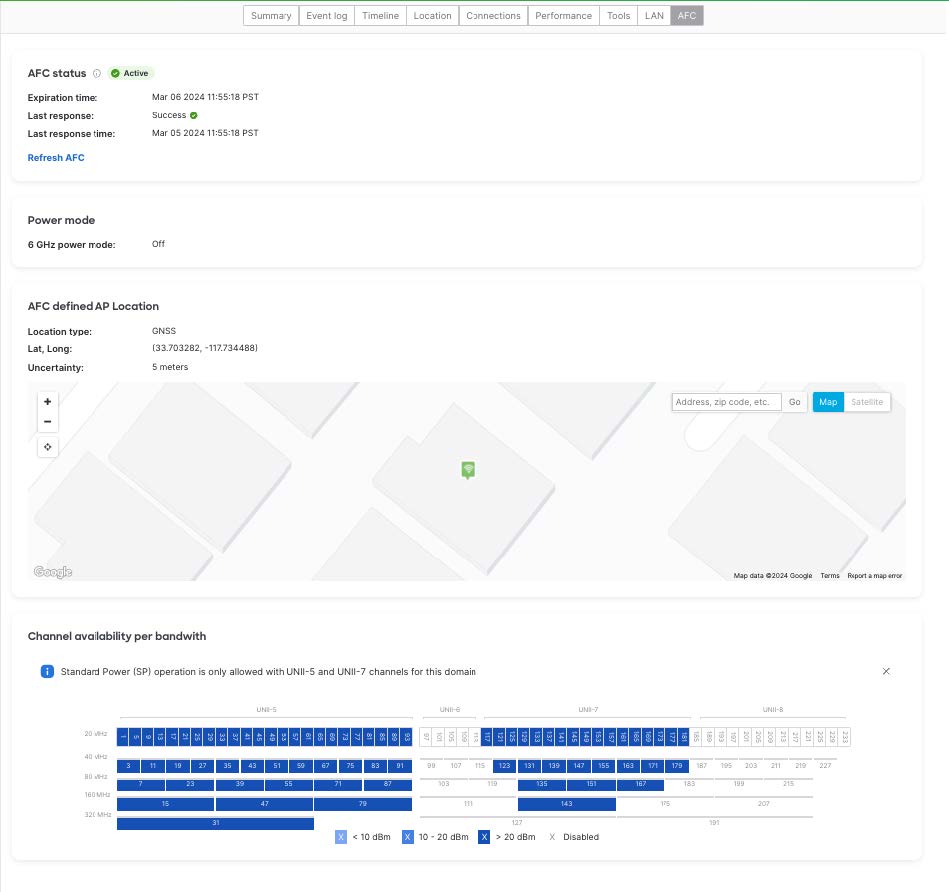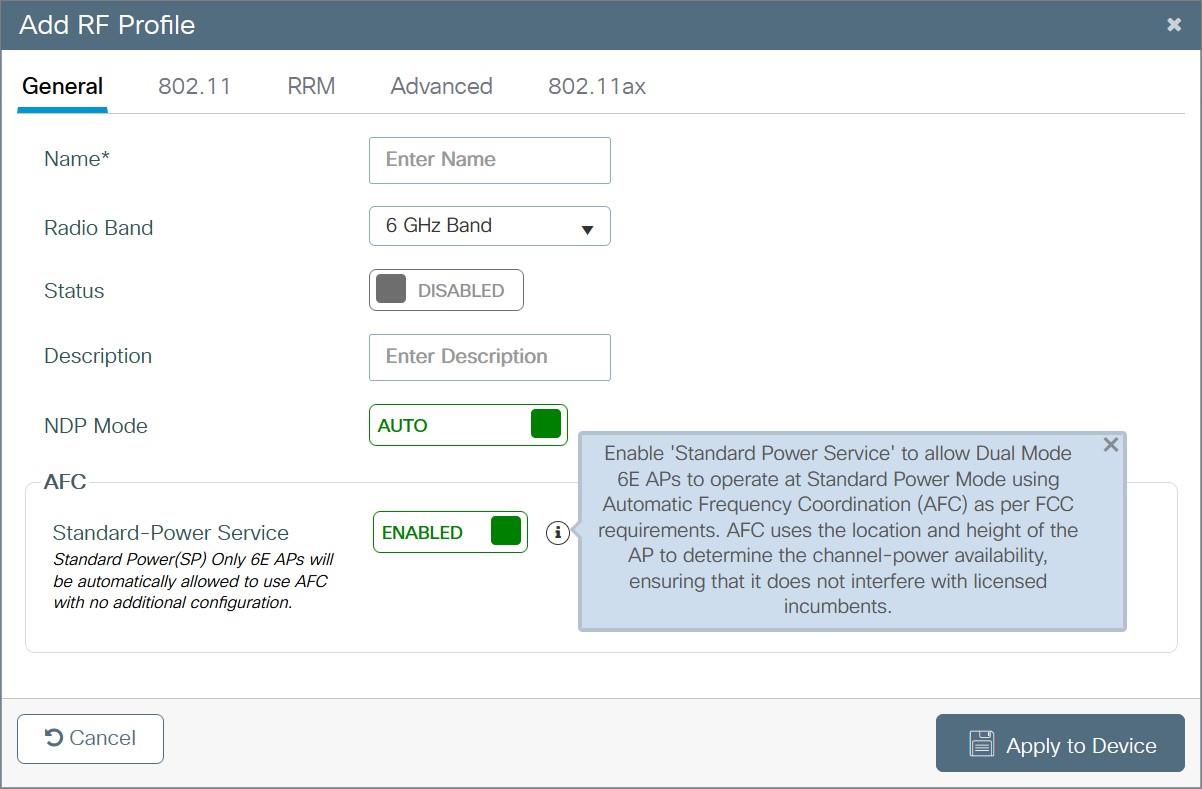It’s an exciting time in the world of Wi-Fi. The Federal Communication Commission (FCC) recently approved Automated Frequency Coordination (AFC) for service providers. Adding to this momentum, the FCC granted standard-power certification to a range of Cisco Wireless Wi-Fi 6E access points. This means you’ll be able to take full advantage of the 6 GHz band to support your wireless-first strategy. But what exactly is AFC and standard power, who requires it, and how can it benefit you and your organization?
6 GHz regulation, standard power, and AFC
The FCC and other regulators around the world have rules around how the 6 GHz band is used. The primary consideration is the protection of incumbent operators in the 6 GHz spectrum. Until now, 6 GHz Wi-Fi was limited to low-power indoor use cases to avoid interference with other operators, such as fixed satellite and broadcast services. To enable standard power use in the 6 GHz band, there was a need to agree on governance over how the 6 GHz spectrum is used.
The recent decision by the FCC to approve AFC now gives us the ability to deploy 6 GHz using standard power for indoor, outdoor, and external antenna use cases. This is a significant development that allows us to utilize all that the 6 GHz band has to offer. And with the United States and the FCC taking the lead, other countries are bound to follow suit.
How does AFC work?
According to a Cisco whitepaper on 6 GHz regulations, the FCC has set up a framework where organizations can offer AFC as a service. This AFC service will dictate how much power an unlicensed 6 GHz-capable device can transmit on any given channel, or whether the device will be allowed to send at all. Without AFC, incumbents could face interference, which would degrade their ability to communicate within the 6 GHz band.
Using standard power requires the AFC to know the location of the access point. All Cisco Wi-Fi 6E access points, regardless of the stack, can support GPS/GNSS or use geo-location propagation techniques for location determination. Using this location data, the AFC system queries an FCC database to identify incumbents in the vicinity of the 6 GHz signal. If incumbents exist, the AFC will automatically block certain channels or reduce power to parts of the spectrum.
The Cisco AFC solution interfaces with AFC cloud services, per FCC requirements, and provides administrators with granular visibility into the available spectrum and channels, as well as the power allocation for each.
AFC is simple to configure via the Cisco Catalyst 9800 Wireless Controller or with the Meraki dashboard.
Figure 1. AFC status monitoring on the Meraki dashboard.
Figure 2. Standard-power configuration in the Cisco Catalyst 9800 Wireless Controller.
The need for standard power
Why would anyone need standard power? There are several reasons, but the main purpose is to broadcast Wi-Fi in the 6 GHz band with more power in both outdoor and indoor areas. This includes indoor locations with lofty ceilings and large open environments. Additionally, outdoor areas can now broadcast in the 6 GHz band, which is only allowed in standard-power mode. The overall goal is to provide reliable, fast, and uninterrupted services to users.
Let’s talk about a few examples. Think about outdoor areas at resorts and sports stadiums and how they connect guests to point-of-sale systems, ticketing, and more. Another example is in manufacturing. Imagine a factory floor with automated guided vehicles (AGVs) and autonomous mobile robots (AMRs) connected reliably over distance.
To learn more about 6 GHz Wi-Fi in manufacturing, make sure to register for this upcoming webinar.
Healthcare is another example—massive buildings with long hallways and soaring atriums as well as large outdoor spaces. Doctors, staff, and patients need to remain connected to ensure quality care and access to resources.
Adventist Health, a Cisco customer, weighed in on the announcement. “We’re excited about certification for AFC and standard power. With standard power, we can extend 6 GHz Wi-Fi across our campuses,” said Ed Vanderpool, Senior Network Manager at Adventist Health. “This will provide our caregivers, staff, and patients the speed and quality of 6 GHz Wi-Fi wherever they chose to roam, with jitter-free voice and video communications, fast access to critical data files, and reliable access to cloud applications. When it comes to Wi-Fi and the recent FCC certifications, we trust Cisco for its reliability, capability, and innovation.”
Register for our 6 GHz webinar with Adventist Health here.
Additionally, with standard power 6 GHz Wi-Fi, mobile service providers can densify and extend 5G with powerful and reliable Wi-Fi when and where available. Likewise, retail, education, government, smart buildings, smart cities, and more can take advantage of standard power 6 GHz wireless to improve connectivity and deliver applications at higher speeds with enhanced security, both indoor and outdoor. Quality wireless is a mission-critical service for all these industries.
Wi-Fi 6E, Wi-Fi 7, and beyond
Cisco has the most comprehensive Wi-Fi 6E portfolio on the market, and as we see Wi-Fi 7 standards emerge, we’ll continue to gain even more capabilities to support a growing number of use cases. Wi-Fi 7 builds on the work we have done in Wi-Fi 6E and will take full advantage of AFC to enable the full power of the 6 GHz band.
One of my team members and fellow wireless product marketers, Stefani Johnson, mentioned in her recent blog post that, “Wi-Fi 7 presents an opportunity to land an exceptionally differentiated customer experience, increased revenue and efficiency, and reduced time-to-value for digital initiatives.”
Cisco Wireless expert Anand Gurumurthy also writes about Wi-Fi 7 and says in his latest post, “[Wi-Fi 7] offers super low latency, more robust connection, higher spectral efficiency, better interference mitigation, more power-saving techniques, better roaming experiences, and increased security.”
With an unprecedented number of devices connecting to today’s wireless networks, along with anticipated growth, we are seeing a transformational shift in connectivity across the places we work, shop, and live. It’s in this uber-connected wireless-first world that 6 GHz Wi-Fi and the next generation of applications are driving a new wireless reality.
We have AFC now, it’s time to start dreaming up new use cases. Look at your needs, evaluate your network, and see how you can benefit from standard-power Wi-Fi 6E.
To learn more about the Cisco Wi-Fi 6E portfolio, visit the Cisco Wireless product page




Congratulations.
Can you articulate a little more regarding how the geo-location propagation techniques for location determination is formulated ?